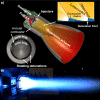Experimental validation of rotating detonation for rocket propulsion
- PMID: 37648704
- PMCID: PMC10469202
- DOI: 10.1038/s41598-023-40156-y
Experimental validation of rotating detonation for rocket propulsion
Abstract
Space travel requires high-powered, efficient rocket propulsion systems for controllable launch vehicles and safe planetary entry. Interplanetary travel will rely on energy-dense propellants to produce thrust via combustion as the heat generation process to convert chemical to thermal energy. In propulsion devices, combustion can occur through deflagration or detonation, each having vastly different characteristics. Deflagration is subsonic burning at effectively constant pressure and is the main means of thermal energy generation in modern rockets. Alternatively, detonation is a supersonic combustion-driven shock offering several advantages. Detonations entail compact heat release zones at elevated local pressure and temperature. Specifically, rotating detonation rocket engines (RDREs) use detonation as the primary means of energy conversion, producing more useful available work compared to equivalent deflagration-based devices; detonation-based combustion is poised to radically improve rocket performance compared to today's constant pressure engines, producing up to 10[Formula: see text] increased thrust. This new propulsion cycle will also reduce thruster size and/or weight, lower injection pressures, and are less susceptible to engine-damaging acoustic instabilities. Here we present a collective effort to benchmark performance and standardize operability of rotating detonation rocket engines to develop the RDRE technology readiness level towards a flight demonstration. Key detonation physics unique to RDREs, driving consistency and control of chamber dynamics across the engine operating envelope, are identified and addressed to drive down the variability and stochasticity observed in previous studies. This effort demonstrates an RDRE operating consistently across multiple facilities, validating this technology's performance as the foundation of RDRE architecture for future aerospace applications.
© 2023. Springer Nature Limited.
Conflict of interest statement
The authors declare no competing interests.
Figures







References
-
- Havskjold, G. Developing innovative products on budget and on schedule–part 1: Identifying and measuring cost drivers correlates technical uncertainty with rework cycles. In 45th AIAA/ASME/SAE/ASEE Joint Propulsion Conference and Exhibit. American Institute of Aeronautics and Astronautics10.2514/6.2009-5436. (2009).
-
- Paxson, D.E., Perkins, H.D. A simple model for rotating detonation rocket engine sizing and performance estimates. In AIAA Scitech 2021 Forum. American Institute of Aeronautics and Astronautics10.2514/6.2021-0192 (2021).
-
- Kailasanath K. Review of propulsion applications of detonation waves. AIAA J. 2000;38:1698–1708. doi: 10.2514/3.14599. - DOI
-
- Bennewitz JW, Bigler BR, Ross MC, Danczyk SA, Hargus WA, Smith RD. Performance of a rotating detonation rocket engine with various convergent nozzles and chamber lengths. Energies. 2021;14(8):2037. doi: 10.3390/en14082037. - DOI
-
- Burr, J.R., Paulson, E. Thermodynamic performance results for rotating detonation rocket engine with distributed heat addition using cantera. In AIAA Propulsion and Energy 2021 Forum. American Institute of Aeronautics and Astronautics10.2514/6.2021-3682 (2021).
Grants and funding
LinkOut - more resources
Full Text Sources

